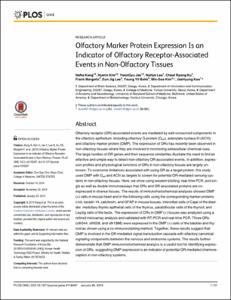Olfactory Marker Protein Expression Is an Indicator of Olfactory Receptor-Associated Events in Non-Olfactory Tissues
- Title
- Olfactory Marker Protein Expression Is an Indicator of Olfactory Receptor-Associated Events in Non-Olfactory Tissues
- Author(s)
- Kang, NaNa ; Kim, Hyerin ; Jae, Yoon Gyu ; Lee, Na Hye ; Ku, Cheol Ryong ; Margolis, Frank ; Lee, Eun Jig ; Bahk, Young Yil ; Kim, Min-Soo ; Koo, Jae Hyung
- Issued Date
- 2015-01
- Citation
- PLoS ONE, v.10, no.1
- Type
- Article
- Keywords
- ODORANT RECEPTOR ; GENE-EXPRESSION ; FUNCTIONAL EXPRESSION ; INTERSTITIAL-CELLS ; SENSORY NEURONS ; URINARY-BLADDER ; MOLECULAR-BASIS ; MOUSE ; OMP ; IDENTIFICATION
- ISSN
- 1932-6203
- Abstract
- Olfactory receptor (OR)-associated events are mediated by well-conserved components in the olfactory epithelium, including olfactory G-protein (Golf), adenylate cyclase III (ACIII), and olfactory marker protein (OMP). The expression of ORs has recently been observed in non-olfactory tissues where they are involved in monitoring extracellular chemical cues. The large number of OR genes and their sequence similarities illustrate the need to find an effective and simple way to detect non-olfactory OR-associated events. In addition, expression profiles and physiological functions of ORs in non-olfactory tissues are largely unknown. To overcome limitations associated with using OR as a target protein, this study used OMP with Golf and ACIII as targets to screen for potential OR-mediated sensing systems in non-olfactory tissues. Here, we show using western blotting, real-time PCR, and single as well as double immunoassays that ORs and OR-associated proteins are coexpressed in diverse tissues. The results of immunohistochemical analyses showed OMP (+) cells in mouse heart and in the following cells using the corresponding marker proteins c-kit, keratin 14, calcitonin, and GFAP in mouse tissues: interstitial cells of Cajal of the bladder, medullary thymic epithelial cells of the thymus, parafollicular cells of the thyroid, and Leydig cells of the testis. The expression of ORs in OMP (+) tissues was analyzed using a refined microarray analysis and validated with RT-PCR and real-time PCR. Three ORs (olfr544, olfr558, and olfr1386) were expressed in the OMP (+) cells of the bladder and thyroid as shown using a co-immunostaining method. Together, these results suggest that OMP is involved in the OR-mediated signal transduction cascade with olfactory canonical signaling components between the nervous and endocrine systems. The results further demonstrate that OMP immunohistochemical analysis is a useful tool for identifying expression of ORs, suggesting OMP expression is an indicator of potential OR-mediated chemoreception in non-olfactory systems. © 2015 Kang et al.
- Publisher
- Public Library of Science
- Related Researcher
-
-
Koo, JaeHyung
- Research Interests 장내미생물/감염균 유래 대사체를 통한 신경염증; 알츠하이머병; 우울증; 당뇨/비만; 대사체/수용체 상호작용에 의한 대사연구
-
- Files in This Item:
-

10.1371_journal.pone.0116097.pdf
기타 데이터 / 3.08 MB / Adobe PDF download



